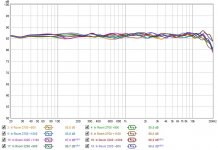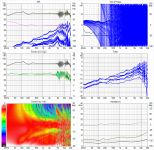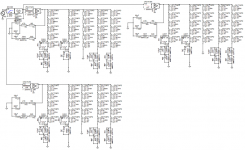No.
I'll elaborate a little...
NCore amps were bought solely to power the subs.
The Goldmund clone is a way different animal. It fits the array and it was very convincing in direct comparison
to 4 other amps. Only one of the other 4 amps impressed me too, and that one is powering the ambient channels.
I'm not starting another amplifier campaign and trust Koldby's judgement and experience, who has build the Goldmund clone.
If I were seduced by the NCore, I'd need 4 more channels because I did notice more synergy between either 4 channels of Pioneer amplifiers or
both of these Mosfet amps with similar output devises playing together. I never intended to become an amplifier connoisseur, in fact I was thought if they
were of good enough quality they ought to sound the same. I did want more oomph than my old Pioneer and did eye the Ncore at one point in time.
However the Goldmund simply made my jaw drop... no doubt about that. The Fetzilla gave me instant goose bumps.
I'm happy with that pairing and have no intention to second guess that decision.
One can change drivers, speakers, amps till we drop. I intent to maximize what I've got. Work with that and not suffer from upgraderitus too much 😀.
I'll elaborate a little...
NCore amps were bought solely to power the subs.
The Goldmund clone is a way different animal. It fits the array and it was very convincing in direct comparison
to 4 other amps. Only one of the other 4 amps impressed me too, and that one is powering the ambient channels.
I'm not starting another amplifier campaign and trust Koldby's judgement and experience, who has build the Goldmund clone.
If I were seduced by the NCore, I'd need 4 more channels because I did notice more synergy between either 4 channels of Pioneer amplifiers or
both of these Mosfet amps with similar output devises playing together. I never intended to become an amplifier connoisseur, in fact I was thought if they
were of good enough quality they ought to sound the same. I did want more oomph than my old Pioneer and did eye the Ncore at one point in time.
However the Goldmund simply made my jaw drop... no doubt about that. The Fetzilla gave me instant goose bumps.
I'm happy with that pairing and have no intention to second guess that decision.
One can change drivers, speakers, amps till we drop. I intent to maximize what I've got. Work with that and not suffer from upgraderitus too much 😀.
Last edited:
I have used UCD400's they worked fine but there is something about them I can't get on with fullrange in the long term. I have now got a Purifi Eigentakt to try at some point but I can make no promises when that will become a priority.Did you or do you have any plans to play/try the Hypex amps on the lines?
//
Thanks for sharing your setup wesayso.
Twenty years ago I played around with a Behringer 2496 (the full version) but controlling audio levels and matching with amplifiers was a nightmare. Today there are many workarounds/solutions I notice, but I gave the device away.
If I can deal with all of this in software I'm much happier. I wasn't aware of all the plugin capabilities in Jriver. Impressed and now considering programming some stuff in Juice. Did you ever look at that?
Twenty years ago I played around with a Behringer 2496 (the full version) but controlling audio levels and matching with amplifiers was a nightmare. Today there are many workarounds/solutions I notice, but I gave the device away.
If I can deal with all of this in software I'm much happier. I wasn't aware of all the plugin capabilities in Jriver. Impressed and now considering programming some stuff in Juice. Did you ever look at that?
Night and day difference between UcD and nCore,I have used UCD400's they worked fine but there is something about them I can't get on with fullrange in the long term. I have now got a Purifi Eigentakt to try at some point but I can make no promises when that will become a priority.
I can attest that if you hear something with the nCores in place it is somewhere else in the chain. They are for all intents and purposes transparent.
I can only imagine how much better the purifi's sound.
I never played with Juice.
I love the open structure in JRiver especially with metaplugin loaded. It makes me think back to my old video editing days, where one could route several streams with similar tools. I can try pretty much anything I can come up with.
I have a Behringer 2496 DEQ, bought in 2011, new in box, never used that I got to get started with the array project. But I took the computer route because I would feel more at home with it.
I love the open structure in JRiver especially with metaplugin loaded. It makes me think back to my old video editing days, where one could route several streams with similar tools. I can try pretty much anything I can come up with.
I have a Behringer 2496 DEQ, bought in 2011, new in box, never used that I got to get started with the array project. But I took the computer route because I would feel more at home with it.
It is always hard to compare thoughts about sound in a written format. I wouldn't say for me that there is a night and day difference between the UCD that I had and the First One or the MOD686 that I use now. All should be transparent by most objective metrics but they do sound different and I do prefer the MOD686 of the three.Night and day difference between UcD and nCore,
I can attest that if you hear something with the nCores in place it is somewhere else in the chain. They are for all intents and purposes transparent.
I can only imagine how much better the purifi's sound.
I was put off from trying Ncore as in discussions with koldby what I did not like about the UCD still seemed apparent to him in the Ncore. There was enough difference in the architecture of the Purifi to give it a punt.
Night and day difference between UcD and nCore,
I can attest that if you hear something with the nCores in place it is somewhere else in the chain. They are for all intents and purposes transparent.
I can only imagine how much better the purifi's sound.
Koldby had the UCD's with him when we tested amplifiers, due to being balanced units we didn't test them at the time.
However, even though I do believe people who say the Ncore to be a very good or great amplifier, I was sold on the Goldmund clone on a pure emotional reaction. The synergy between the arrays and the amplifier just worked. A midrange that was sweet and inviting, thrilling even. The Fetzilla had that quality too. Especially the midrange. It just made the voices sound, heck... I don't know what to say or how to describe it. It just draws me into the music. It rendered a believable picture of a true performance.
The way the Goldmund clone made bass notes sound dropped my jaw, I never thought it was possible to be that firm, have so much control. I had never heard my arrays do that before. No contest between any of the other amps and the Goldmund in that department.
I'm sounding like a true audiophile here, no offence meant. It was a moment one had to witness I guess. I think I may have begged Koldby to let me keep that amplifier for a while longer 😀.
In the end, even the temporary pré amp that was used in that session turned out to have played a role.
Meaning that it should al fit together, to create that synergy. I would have never figured that, from the lessons of some mayor people in the audio world.
I've tested my Xonar Essence vs the Musical Fidelity M1 DAC (more than) a few times. My son noticed that difference without me telling him anything had changed. So I let him choose without him knowing what was playing. He wouldn't know what a DAC is anyway, but he loves music. We both agreed that the M1 is the one that won that little contest. But it doesn't mean I'll be buying and testing many more DAC's. I do realize even small changes can sound way different.
For instance the Goldmund is a dual mono in one chassis. This was obvious in imaging, image positions shifted with that amp having more spread in certain passages.
It didn't make my audio hobby any easier, I would have been fine with amplifiers sounding alike.

Before you know you'll want silver cables forged at midnight.... Audiophiles do so 😉
I have always found it near impossible to compare amps due to minimal differences in loudness and strong placebo effects, but if your son could tell them blindly apart it might be that I never had speakers good enough to bring out these differences.
What, if I may ask, was the reasoning behind 25 Vifa's versus say 12? Linear distortion is a valid issue at high volumes, but you seem to have a smallish room whre disco volumes are not needed. What made you settle for 25?
I have always found it near impossible to compare amps due to minimal differences in loudness and strong placebo effects, but if your son could tell them blindly apart it might be that I never had speakers good enough to bring out these differences.
What, if I may ask, was the reasoning behind 25 Vifa's versus say 12? Linear distortion is a valid issue at high volumes, but you seem to have a smallish room whre disco volumes are not needed. What made you settle for 25?
The floor to ceiling action of a long straight array.
It acts different from a finite array in the way how it works inside a room with floor and ceiling. A Vituixcad simulation could tell you that.
Koldby had told me the arrays were a perfect tool to hear differences between amplifiers. I was always like: yeah, right... I could surely measure it, right?
I can't state it like that anymore. Not entirely. Yes, I've been able to measure differences. But I do draw my own tonal curves and can do so with quite a bit of accuracy and repeatability. That is what I love about the arrays. It gets you a good direct vs indirect sound opportunity, with a little care.
That can be shown with the measurement at the listening spot:

This isn't a close up measurement, this is taken at the sweet spot with both arrays playing. Which means you do get to hear the direct sound, without the room messing it up too much.
The vertical row of drivers each have differing positions as seen from a listeners perspective. Meaning we don't have an obvious floor bounce or a ceiling creating dips in that early arrival of sound. It kind of gets averaged out. With DSP tools like DRC-FIR, Audiolense or Acourate, we can reconstruct that first wave front as much as possible. (by changing what is sent to the amplifier). You do get that behavior at more than one spot, meaning it does not change when moving your head. It is extremely stable in that regard.
Compared to a single driver, it would show much more variety when you move just a little bit. It does take treatment on parallel surfaces to get the above. But compared to many other types of speakers this is a rather unique quality.
I have been able to hear minute changes, or errors (for instance in my processing) and be able to measure such anomalies. It makes it easier to start trusting what one measures. As there is less in the way, as if you were sitting way more in the nearfield of speakers(*), making reflections come in later.
(*)= where most take their measurements to avoid the reflections.
I've tried to find a balance between direct and indirect sound that I find pleasing. That meant adding (virtual) ambience as I robbed the room of energy by placing 3 absorbing panels on parallel planes. This way I get to control that part to my liking. Making the room (+ speakers) disappear and having a sound stage that sounds large when it is recorded like that and small and intimate if the recorded space shows its queues within the recording. A kameleon if you like, best experienced with closed eyes, not to let the eyes distract you from the audible queues.
Sorry, way longer answer than what you asked for... I do that a lot!
My apologies 😀
It acts different from a finite array in the way how it works inside a room with floor and ceiling. A Vituixcad simulation could tell you that.
Koldby had told me the arrays were a perfect tool to hear differences between amplifiers. I was always like: yeah, right... I could surely measure it, right?
I can't state it like that anymore. Not entirely. Yes, I've been able to measure differences. But I do draw my own tonal curves and can do so with quite a bit of accuracy and repeatability. That is what I love about the arrays. It gets you a good direct vs indirect sound opportunity, with a little care.
That can be shown with the measurement at the listening spot:

This isn't a close up measurement, this is taken at the sweet spot with both arrays playing. Which means you do get to hear the direct sound, without the room messing it up too much.
The vertical row of drivers each have differing positions as seen from a listeners perspective. Meaning we don't have an obvious floor bounce or a ceiling creating dips in that early arrival of sound. It kind of gets averaged out. With DSP tools like DRC-FIR, Audiolense or Acourate, we can reconstruct that first wave front as much as possible. (by changing what is sent to the amplifier). You do get that behavior at more than one spot, meaning it does not change when moving your head. It is extremely stable in that regard.
Compared to a single driver, it would show much more variety when you move just a little bit. It does take treatment on parallel surfaces to get the above. But compared to many other types of speakers this is a rather unique quality.
I have been able to hear minute changes, or errors (for instance in my processing) and be able to measure such anomalies. It makes it easier to start trusting what one measures. As there is less in the way, as if you were sitting way more in the nearfield of speakers(*), making reflections come in later.
(*)= where most take their measurements to avoid the reflections.
I've tried to find a balance between direct and indirect sound that I find pleasing. That meant adding (virtual) ambience as I robbed the room of energy by placing 3 absorbing panels on parallel planes. This way I get to control that part to my liking. Making the room (+ speakers) disappear and having a sound stage that sounds large when it is recorded like that and small and intimate if the recorded space shows its queues within the recording. A kameleon if you like, best experienced with closed eyes, not to let the eyes distract you from the audible queues.
Sorry, way longer answer than what you asked for... I do that a lot!
My apologies 😀
Ok, one more... the audiophile in me wants copper! Possibly tinned copper for durability to guard the wires against corrosion. I't let others fight over the silver.
If copper or better yet tin plated copper was good enough for the pioneers of Audio in the Western Electric days, it will be good enough for me. I do like stuff that lasts, stands the test of time. My arrays are serviceable and made from durable materials.
Copper it is! 😀 Testing tin plated copper wires might happen, from that point of view of durability. I actually did wire tests long ago and that did show me that corroded old copper wires sound worse than fresh copper. A measurable difference as locked somewhere in this thread. (it tuned out the old wire was green under it's jacket, the wires under investigation were about 25 years old)
I measured no or negligible difference between solid copper core house hold wiring and multi core stiff but bendable copper wires of similar total thickness.
Someone willing to prove me wrong will be welcome if the world allows such a thing again. He or she will have to bring their own silver.
If copper or better yet tin plated copper was good enough for the pioneers of Audio in the Western Electric days, it will be good enough for me. I do like stuff that lasts, stands the test of time. My arrays are serviceable and made from durable materials.
Copper it is! 😀 Testing tin plated copper wires might happen, from that point of view of durability. I actually did wire tests long ago and that did show me that corroded old copper wires sound worse than fresh copper. A measurable difference as locked somewhere in this thread. (it tuned out the old wire was green under it's jacket, the wires under investigation were about 25 years old)
I measured no or negligible difference between solid copper core house hold wiring and multi core stiff but bendable copper wires of similar total thickness.
Someone willing to prove me wrong will be welcome if the world allows such a thing again. He or she will have to bring their own silver.
And to throw in some more shade...
I did a small test with copper cables a while back.
I used 2mm lamp cord, multi strand, vs 2mm solid core, vs some silver wires my neighbor swore about.
I felt the solid core had more meat on the bass.
A bit harder to wire up, since it is not as flexible, but not too bad.
I did a small test with copper cables a while back.
I used 2mm lamp cord, multi strand, vs 2mm solid core, vs some silver wires my neighbor swore about.
I felt the solid core had more meat on the bass.
A bit harder to wire up, since it is not as flexible, but not too bad.
If copper or better yet tin plated copper was good enough for the pioneers of Audio in the Western Electric days, it will be good enough for me. I do like stuff that lasts, stands the test of time. My arrays are serviceable and made from durable materials.
Copper it is! 😀 Testing tin plated copper wires might happen, from that point of view of durability. I actually did wire tests long ago and that did show me that corroded old copper wires sound worse than fresh copper. A measurable difference as locked somewhere in this thread. (it tuned out the old wire was green under it's jacket, the wires under investigation were about 25 years old)
I measured no or negligible difference between solid copper core house hold wiring and multi core stiff but bendable copper wires of similar total thickness.
And to throw in some more shade...
I did a small test with copper cables a while back.
I used 2mm lamp cord, multi strand, vs 2mm solid core, vs some silver wires my neighbor swore about.
I felt the solid core had more meat on the bass.
A bit harder to wire up, since it is not as flexible, but not too bad.
For similar reasons I have settled on various gauges of PE2 magnet winding wire for cables. I assume the polyamide coating should keep it from oxidation for decades, if not centuries, from my experience stripping old transformers. You can also turn it into Litz type cable constructions.
Inspired by a post from emailtim I ran some Octave scripts as supplied by DRC-FIR.
I ran the script comparing the sim data I used in Vituixcad to get a comparison between my pré-EQ stage and after running DRC-FIR.
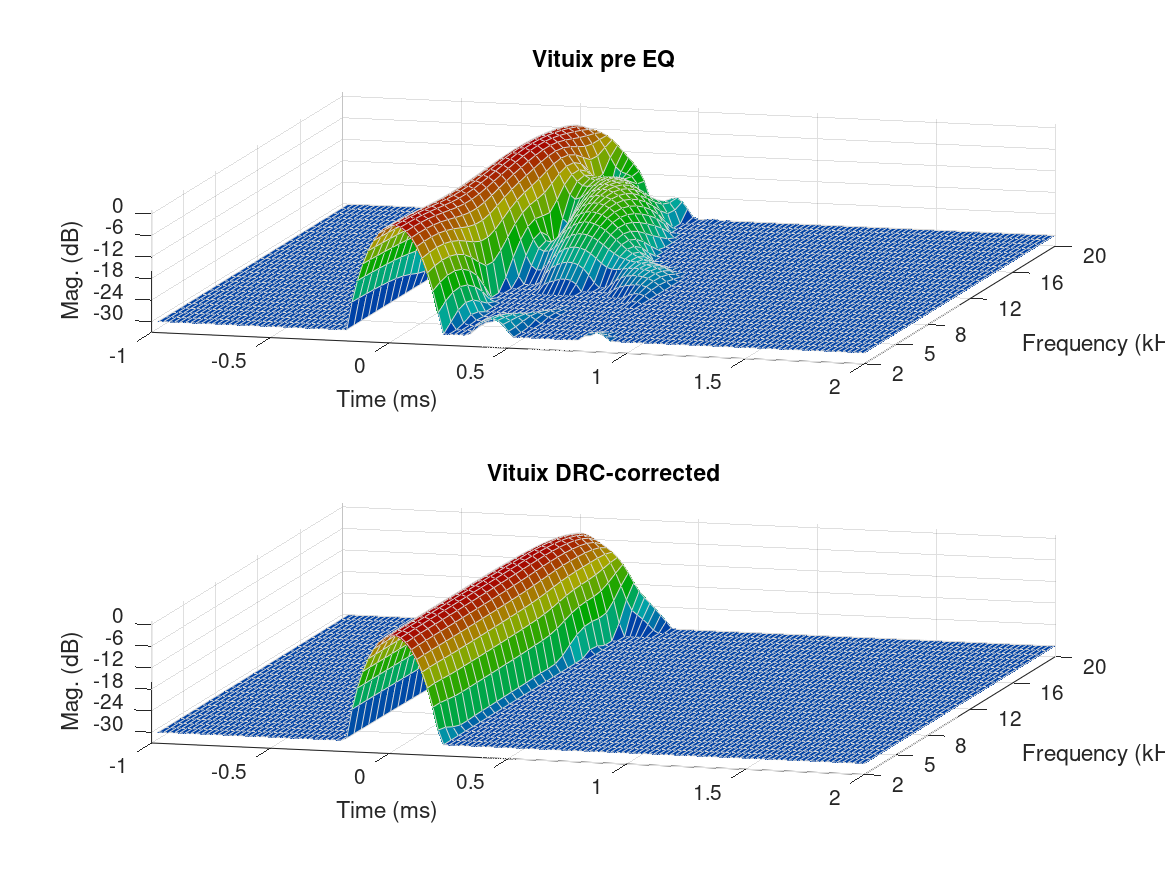
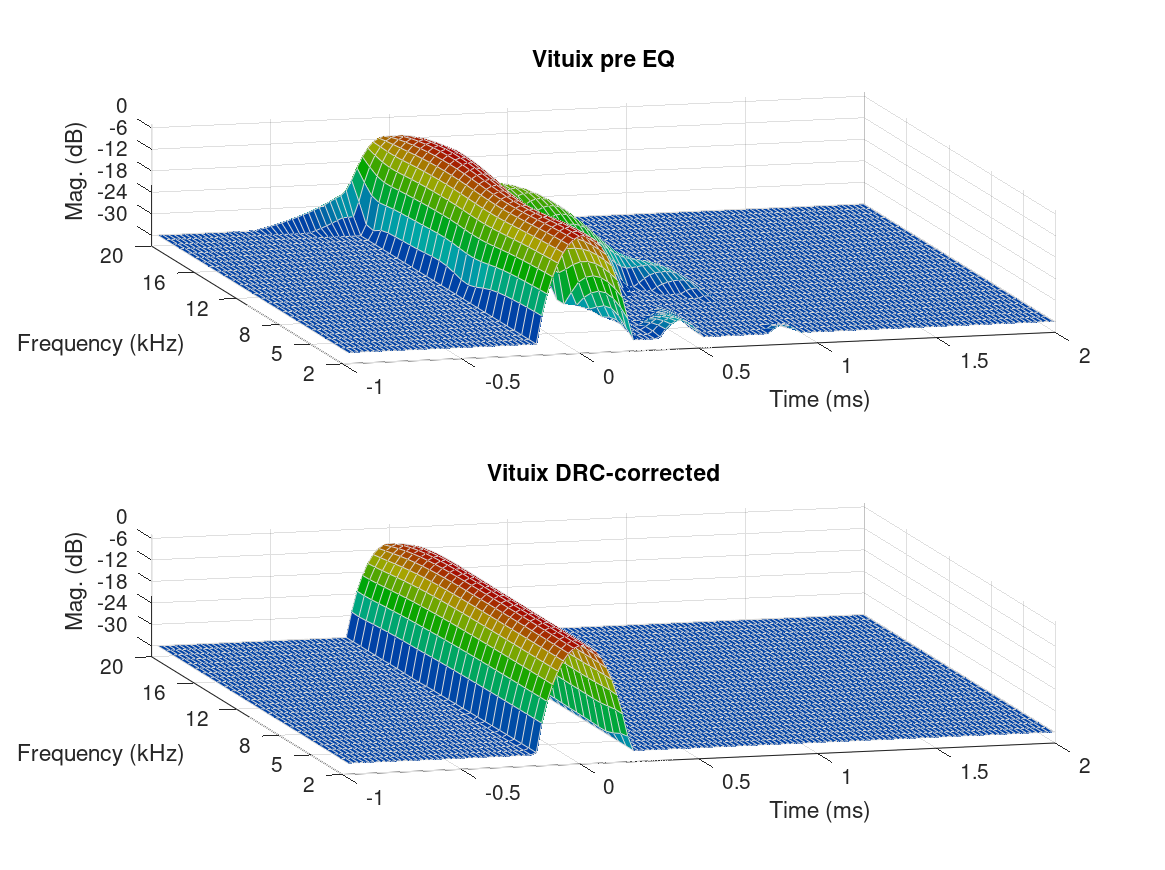
For this to work I did have to jump trough various edits, probably because of short files used etc, as they are not representing measured data but are limited length files I used to sim my arrays.
But my newly created template for these sims seems to work quite well.
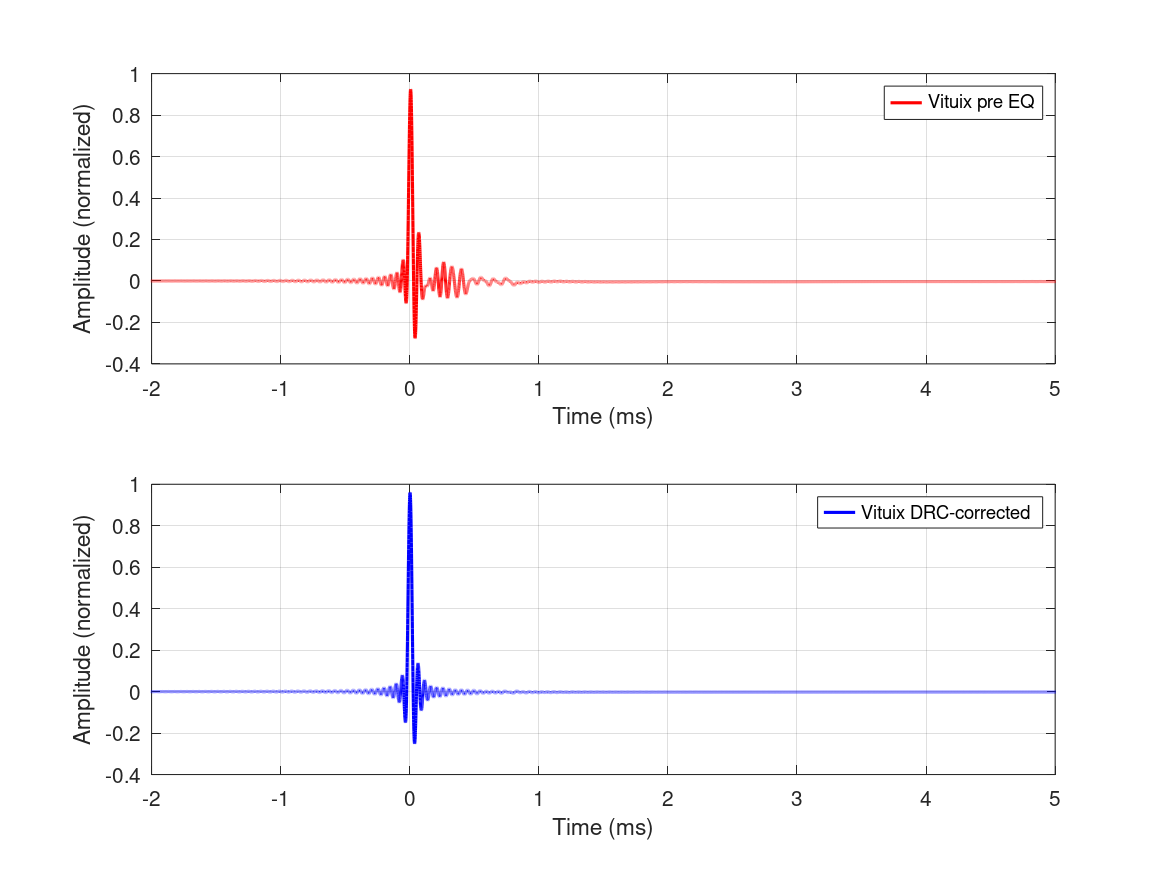
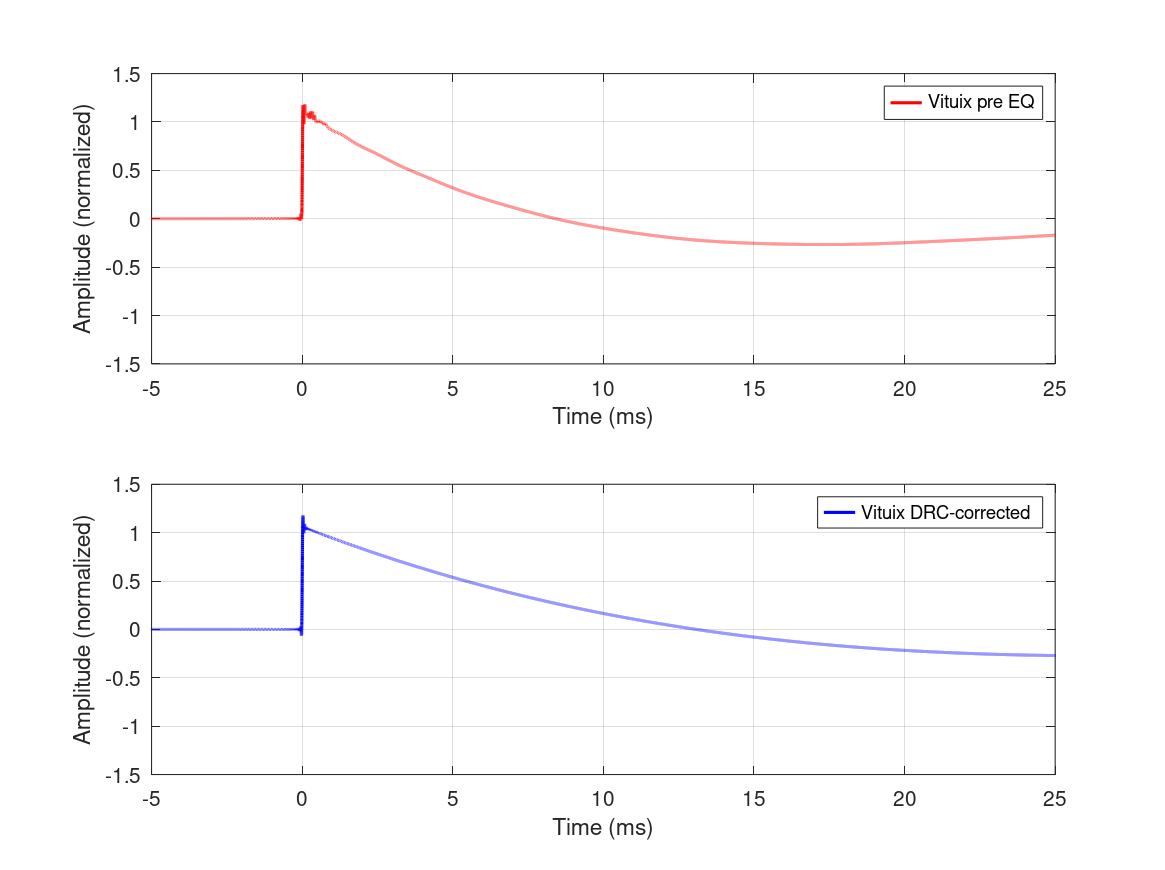
(this is a pure minimum phase correction, on a Vituixcad simmed line array, which is why it looks this clean)
The resolution of these seems limited compared to just importing the IR into REW. But they do provide a view from both sides, something I've always wished for within REW. As I already nagged John about the wavelet mode that made similar plots to APL-TDA and getting a user adjustable "span before peak" in these wavelet plots (to be able to see pré-ringing for us digital DSP users) I didn't dare ask for a 'kind of a reversed' waterfall plot, showing us the pré-peak area where ringing would occur. I still think that would be interesting and useful to keep an eye on, but the above Octave graph tools do not seem detailed enough to provide a solution.
I ran the script comparing the sim data I used in Vituixcad to get a comparison between my pré-EQ stage and after running DRC-FIR.
For this to work I did have to jump trough various edits, probably because of short files used etc, as they are not representing measured data but are limited length files I used to sim my arrays.
But my newly created template for these sims seems to work quite well.
(this is a pure minimum phase correction, on a Vituixcad simmed line array, which is why it looks this clean)
The resolution of these seems limited compared to just importing the IR into REW. But they do provide a view from both sides, something I've always wished for within REW. As I already nagged John about the wavelet mode that made similar plots to APL-TDA and getting a user adjustable "span before peak" in these wavelet plots (to be able to see pré-ringing for us digital DSP users) I didn't dare ask for a 'kind of a reversed' waterfall plot, showing us the pré-peak area where ringing would occur. I still think that would be interesting and useful to keep an eye on, but the above Octave graph tools do not seem detailed enough to provide a solution.
Last edited:
Today I've been playing with the new template on an old measurement. Looks good to go, with a RePhase correction for phase.
I also decided to check a 30 cm listening window, at listening distance of 2700 mm and 3200 mm. Here's the graph:
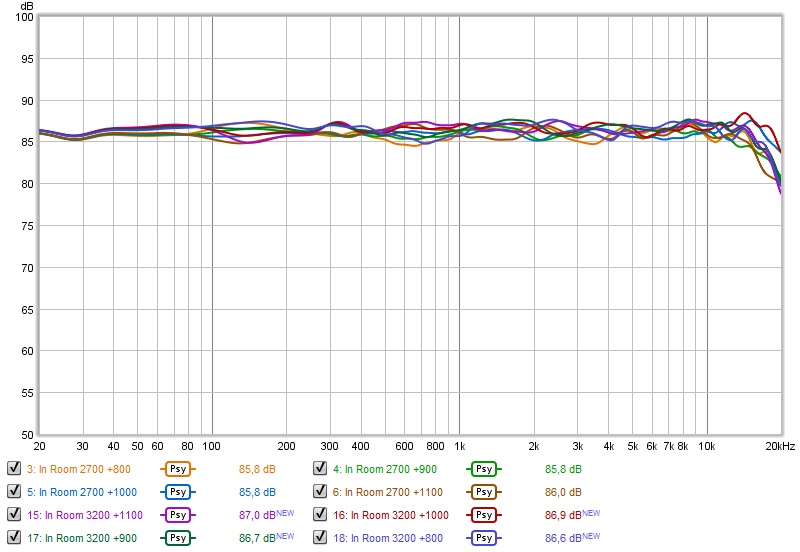
It is in these simulations that the filtered array does wonderful compared to the unfiltered version all throughout the frequency band. Very little variation overall with 2dB set to floor and ceiling absorption.
I did realize the simulations from Vituixcad will differ from reality on a couple of details. All trends I did see in my measurements do show up, but the exact behavior will be slightly different, as the floor and ceiling will play a role in lengthening the array behavior. One of the old sims where nc535 had a copy of the array below the floor showed the most similarities to my measured results. That's when I started to take notice and join the sim fun. The floor and ceiling settings do go a long way to predict the in room response, but actual results will vary slightly.
I also decided to check a 30 cm listening window, at listening distance of 2700 mm and 3200 mm. Here's the graph:
It is in these simulations that the filtered array does wonderful compared to the unfiltered version all throughout the frequency band. Very little variation overall with 2dB set to floor and ceiling absorption.
I did realize the simulations from Vituixcad will differ from reality on a couple of details. All trends I did see in my measurements do show up, but the exact behavior will be slightly different, as the floor and ceiling will play a role in lengthening the array behavior. One of the old sims where nc535 had a copy of the array below the floor showed the most similarities to my measured results. That's when I started to take notice and join the sim fun. The floor and ceiling settings do go a long way to predict the in room response, but actual results will vary slightly.
Attachments
Sometimes it isn't fun to be as curious ar I am. Due to writing down my thoughts this afternoon, I now have a new model with a groundplane mirror again, and wondering if I should include the ceiling mirror as well.
(for now I just activated the ceiling function)
If you really want an accurate prediction, this method will get you close! Closer than just turning on the floor and ceiling reflections, as now I'm seeing all features one sees in real life measurements. The in-room prediction didn't change much, so it's just a verification for me. Another model to learn from.
It is quite accurate though (looking at Total SPL IR), and I think it may teach me a thing or two.
It's quite a burden in Vituixcad, meaning it will get slow.
(for now I just activated the ceiling function)
If you really want an accurate prediction, this method will get you close! Closer than just turning on the floor and ceiling reflections, as now I'm seeing all features one sees in real life measurements. The in-room prediction didn't change much, so it's just a verification for me. Another model to learn from.
It is quite accurate though (looking at Total SPL IR), and I think it may teach me a thing or two.
It's quite a burden in Vituixcad, meaning it will get slow.
The in-room predictions follow the earlier model exactly, but using this and comparing to my measured results made it possible to use an educated guess on the floor absorption. (by filtering the results at certain points in the Filtered IR tab within REW). It looks to be about 4 dB (where it counts, at the floor reflection of the lobes).
Attachments
Cool! It's hard to guess the amount of absorption of the floor and ceiling, so it's very interesting that you could model it and compare to measurements. Are you working on the ceiling reflections as well?
I probably will, though this experiment did prove that the in-room calculations using the simple floor and ceiling settings in Vituixcad match well with the actual 'under floor' model. It does change the final needed FIR file shape as the floor mirror does work to make the array seem taller.
If you want to see what you can expect, as far as the IR goes, model that under floor and above ceiling mirror. As that would be a quite close match to what one measures out in the room. The 'Total SPL' IR can be exported as a wave file, while the 'in room' results are simpler text results.
The modeled mirror array's will show you all the 'warts' you will see when you measure indoors. Flipping trough the waterfall settings can show you what that does over time. I've done that a million times on real life measurements, including many of fellow array builders and it is cool to see the Vituixcad model resembling that behavior.
It also makes clear why a FIR correction with a frequency dependent window, like DRC-FIR has is superior to just EQ-ing the in-room frequency curve.
In other words: worth it to learn from.
EDIT: if I had tools like Vituixcad when I started with this build, I can't imagine ever getting around to actually building something 😀. There's always something to optimize, right around the corner... Which is the reason I haven't started playing with ABEC yet. Because I do not need any more distractions and I first need to finish what I started 9at least, when the weather improves over here to actually be able to do it. I'm watching the long term forecasts and have plans for a short break from work as soon as the temperature rises 😀.
If you want to see what you can expect, as far as the IR goes, model that under floor and above ceiling mirror. As that would be a quite close match to what one measures out in the room. The 'Total SPL' IR can be exported as a wave file, while the 'in room' results are simpler text results.
The modeled mirror array's will show you all the 'warts' you will see when you measure indoors. Flipping trough the waterfall settings can show you what that does over time. I've done that a million times on real life measurements, including many of fellow array builders and it is cool to see the Vituixcad model resembling that behavior.
It also makes clear why a FIR correction with a frequency dependent window, like DRC-FIR has is superior to just EQ-ing the in-room frequency curve.
In other words: worth it to learn from.
EDIT: if I had tools like Vituixcad when I started with this build, I can't imagine ever getting around to actually building something 😀. There's always something to optimize, right around the corner... Which is the reason I haven't started playing with ABEC yet. Because I do not need any more distractions and I first need to finish what I started 9at least, when the weather improves over here to actually be able to do it. I'm watching the long term forecasts and have plans for a short break from work as soon as the temperature rises 😀.
Last edited:
As expected, right? I just had to try. I don't know how usable it is though. As there are certain aspects within Vituixcad that prevent you to go over 2 meter in the driver placement, but then the actual schematics editing allows you to do so. But once I start moving the whole sequence it goes terribly wrong. I won't start nagging Kimmo to fix that. As it is enough confirmation for me that for all practical purposes one can trust the floor/ceiling settings within Vituix.
Anyway, here's the 6-pack with proper driver placement and both mirror images:
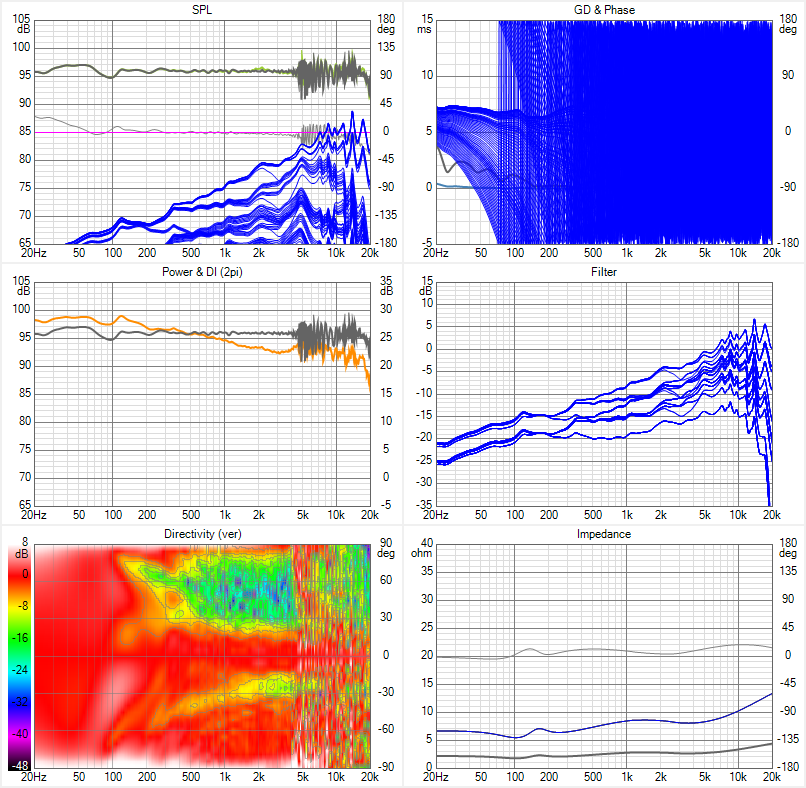
The schematic is turning in to something unworkable:
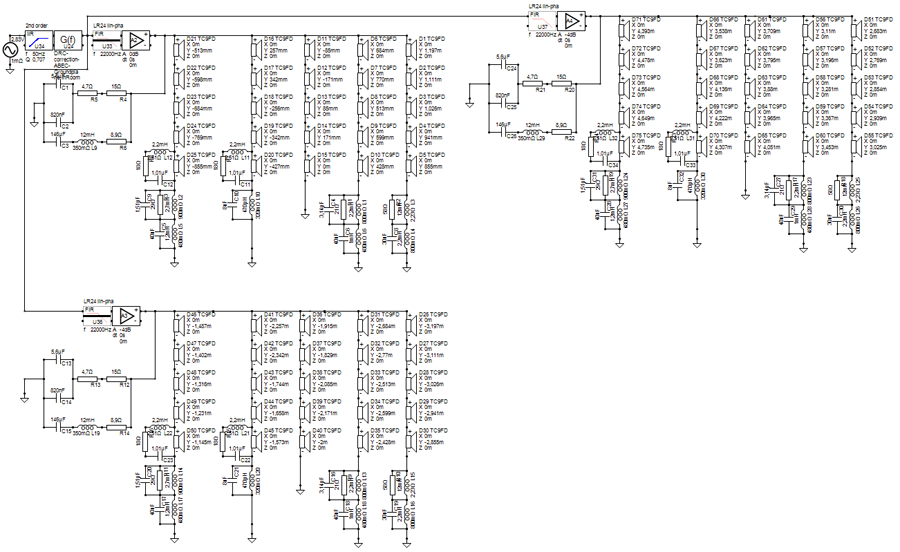
Maybe a step too far at this point 😉. But it was interesting enough to try.
Anyway, here's the 6-pack with proper driver placement and both mirror images:
The schematic is turning in to something unworkable:
Maybe a step too far at this point 😉. But it was interesting enough to try.
Attachments
Last edited:
- Home
- Loudspeakers
- Full Range
- The making of: The Two Towers (a 25 driver Full Range line array)
